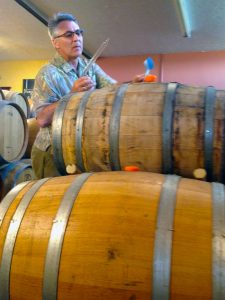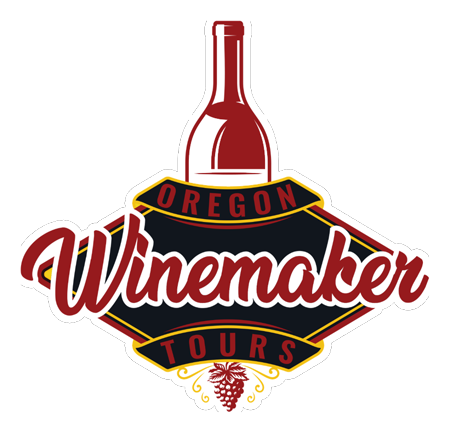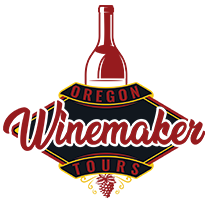Cellaring
A Personal And Custom Vineyard Tour

Carmine Using A Wine Thief
Using Numerous Barrel Types
There are numerous barrel types to use in achieving a winemaker’s flavor and phenolic goals. Ideally, a data base is kept for individual barrels: wine fruit source and harvest date, as well as the age, size, forest-source and toast level of the barrel itself. Winning winemaking teams learn to pair certain cooperages and oak types with specific vineyard blocks to create the best wine. Oak barrels build complexity and depth in wines; the goal is always to achieve harmony between the wine’s fruit flavors and oak influence. My favorite barrel type is Oregon Oak (Garry Oak)!
Enhancing With Yeast Variation
Yeast variation and its influence on wines is tracked; some yeasts enhance floral aromatics while some give more tropical fruit characteristics, and others are more austere or provide mid-palate weight. Top wines typically spend 14 to 18 months in barrel. Cellars are carefully monitored to maintain ideal levels of humidity, temperature and air circulation.
Tasting and Blending
Tasting and blending exercises are conducted over time and throughout the cellar to arrive at ideal blends. There are many layers of complexity generated during various cellar stages which provide a rich palette of flavor, texture, and aroma elements from which a winemaker can choose. These elements include terroir aspects, variations in batch and tank management, yeast selection and the oak regime.
The Process of Aging Wine
All wine ages in two ways: aerobically (with oxygen) while fermenting, being pressed, racked and prepared for bottling, and anaerobically after bottling. Subtle chemical changes occur after bottling and away from air; these are critical for developing the best bouquet and flavor complexity in wines. Aging a bottle allows tannin levels to drop and the fruit and complexity of the wine to be fully tasted. Unfortunately, most wine in the USA is not sufficiently aged to allow this process to occur, before being consumed.
The process of aging wine is not difficult but has some absolute parameters. An excellent natural cork is currently the slowest oxygen admitter to a bottle. A natural cork allows just the right amount of oxygen to slowly pass into the bottle over time, softening tannins gently and adding complexity. With a cork closure, the wine’s temperature cannot vary rapidly, or a closure failure may happen. Higher temperatures age wine faster. While I prefer a faster 68F degrees aging rate, in a 10-20% humidity space, temperatures between 34-74 F are O.K. If you age wines, keep the temperature as steady as possible. Basements are ideal aging spaces.
More bottling is being done with screwcaps. I believe screwcaps are excellent to seal and age wine up to 8 years; after that I think they may fail in their ability to achieve effective further aging.
How much time to age? This differs from wine to wine. Barrel aged white wines can often be aged effectively for 6-15 years. Simpler whites won’t last that long without losing some fresh attributes. Pinot Noir is the only red wine that is “proper to drink young;” 6-10 years after the vintage date. A Pinot Noir wine aged 8-15 years is considered “nicely aged.” The heavier the tannin profile in a red wine, the more aging it can take, but it can only be as good as its’ balance. For example, a good well-balanced tannic Cabernet can age 30 years and still taste amazing! The longer you plan to age a wine, the more you should pay attention to lower cellar temperatures. Fifty-five degrees is the industry standard on these long aged wines for resale and storage vaults. For many tasty reasons I prefer ALL my wines to be bottle aged minimally two years. –Please ask me about Balance and Aging, if you desire more information.
Fining and Filtering
Fining and filtering are the two processes which control how much sediment might occur in bottled wine. These two processes are usually done just before bottling. Please know that natural fining and long barrel aging can help greatly with sediment issues – ask me about these if you wish. Simply know this: both fining and filtration strip the wine of some good natural wine components and flavors.
Fun fact -most wine lovers of nicely aged wines will tell you that all the best wines require a decanter, to decant the solids that fall out after a wine has some age to it.
While wine bottles come in all shapes and sizes, the bottle shape doesn’t make a difference in terms of impacting a wine’s flavor. In the past, wine bottles often represented a particular type of grape and region. With the huge amount of new world wines, bottle type has lost much of its history and tradition. Most winemakers choose to go with one of these three bottle types: the Bordeaux Bottle (once only hot climate wines), the Burgundy Bottle (once only cool-climate wines) and the Alsace Bottle (again cool-climate wine). Americans often think Alsace bottles contain sweet wines, but that is not necessarily a traditional truth.
Open, pour, sip, savor, & Cheers!

